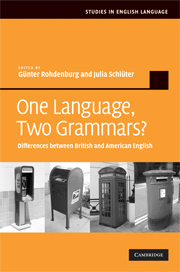Book contents
- Frontmatter
- Contents
- List of figures
- List of tables
- List of contributors
- Introduction
- 1 Colonial lag, colonial innovation or simply language change?
- 2 Compound verbs
- 3 The formation of the preterite and the past participle
- 4 Synthetic and analytic comparatives
- 5 Phonology and grammar
- 6 Prepositions and postpositions
- 7 Argument structure
- 8 Reflexive structures
- 9 Noun phrase modification
- 10 Nominal complements
- 11 Non-finite complements
- 12 The present perfect and the preterite
- 13 The revived subjunctive
- 14 The mandative subjunctive
- 15 The conditional subjunctive
- 16 Tag questions
- 17 The pragmatics of adverbs
- 18 How different are American and British English grammar? And how are they different?
- 19 New departures
- Bibliography
- Index
15 - The conditional subjunctive
Published online by Cambridge University Press: 03 July 2009
- Frontmatter
- Contents
- List of figures
- List of tables
- List of contributors
- Introduction
- 1 Colonial lag, colonial innovation or simply language change?
- 2 Compound verbs
- 3 The formation of the preterite and the past participle
- 4 Synthetic and analytic comparatives
- 5 Phonology and grammar
- 6 Prepositions and postpositions
- 7 Argument structure
- 8 Reflexive structures
- 9 Noun phrase modification
- 10 Nominal complements
- 11 Non-finite complements
- 12 The present perfect and the preterite
- 13 The revived subjunctive
- 14 The mandative subjunctive
- 15 The conditional subjunctive
- 16 Tag questions
- 17 The pragmatics of adverbs
- 18 How different are American and British English grammar? And how are they different?
- 19 New departures
- Bibliography
- Index
Summary
Introduction
The subjunctive is one of the most striking and most frequently commented-on domains of grammatical contrasts between the two major national varieties of English. Many surveys and specific studies have remarked on the greater propensity of AmE to use the subjunctive in contexts where BrE resorts to two other options, the indicative or modal constructions (see Johansson 1979: 201, 1980: 90–1, Erdmann 1981: 120–3, Quirk et al. 1985: 157, Johansson and Norheim 1988, Algeo 1992: 600, 2006: 263–4, Denison 1998: 264, Peters 2004: 520). However, those that widen the perspective to include the history of the phenomenon have come to contradictory conclusions. On the one hand, Turner (1980: 272–3), Görlach (1987: 53) and Lass (1987: 282) seem to assume a continuity between older forms of English and the frequent use of the subjunctive in AmE, and accordingly label it an ‘archaic expression’, a ‘retention’ or a ‘conservatism’. In a similar vein, Algeo (1992: 604) and Peters (1998: 98, 100) suggest that the higher levels of subjunctive use in AmE require no particular explanation, being simply another effect of the ‘colonial lag’ often adduced in such cases.
- Type
- Chapter
- Information
- One Language, Two Grammars?Differences between British and American English, pp. 277 - 305Publisher: Cambridge University PressPrint publication year: 2009
- 8
- Cited by



